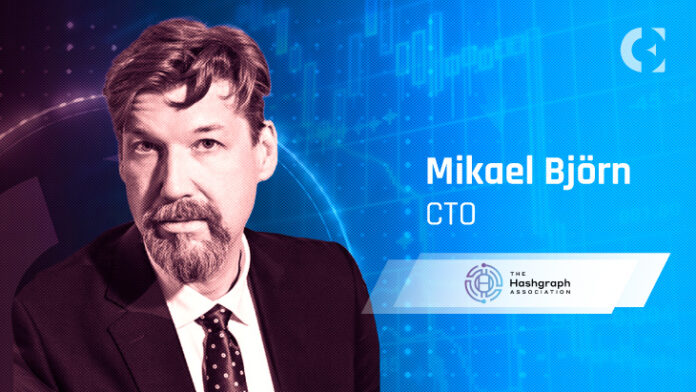Based in Switzerland, The Hashgraph Association is an organization focused on building an innovative ecosystem for startups, enterprises, and government institutions around the world by leveraging the capabilities of Hedera Hashgraph to design and develop enterprise-grade solutions and decentralized applications.
The Coin Edition team had the opportunity to interview Mikael Björn, Chief Technology Officer (CTO) of The Hashgraph Association. In this interview, Björn discusses the transition from Web2 to Web3, the Hedera Hashgraph, plans for the future, and more.
Interviewer: As one of the speakers at the recent Global Blockchain Congress event, how was your experience participating in this gathering?
Mikael Björn: As I have been talking at several venues over the years, I was pleased by this event’s business focus, which other Blockchain conferences often lack.
Interviewer: Could you please share your experience and insights on navigating the transition from Web2 to Web3?
Mikael Björn: My journey from Web1 to Web2, and now Web3, has been a journey of data liberation. The concept of the “prosumer” (producer/consumer) during Web2 was never fulfilled as the produced content or data was always in the hands of centralized entities. This meant that the producer could never gain the number of rewards that were promised during Web2. Web3 gives back control and ownership of the data, so we’ve seen many more interesting business models popping up in Web3. We are still transitioning from Web2 to Web3, but the speed of this transition is accelerating, and we can see that when we look at the old monolithic entities of Web2.
Interviewer: As stated on your website, one of the primary missions of your organization is to raise awareness and achieve widespread adoption of the Hedera Hashgraph. What sets Hedera Hashgraph apart from other networks?
Mikael Björn: I would say that the singular most important part is that Hedera is made for enterprises and large organizations. The technology makes it possible to achieve the speed, efficiency, and financial predictability that a large organization needs to rely on. Hedera is ready from the start to be applied to all the original business use cases of a Distributed Ledger Technology (DLT) or a Blockchain. Thanks to our Govern Council, this has been our North Star for many years.
Interviewer: This month, Seagrass and the Hashgraph Association announced the launch of a co-funded carbon credit Web3 identity wallet. Could you explain more about this Web3 wallet and what the main goal behind this collaboration is? Can you also speak about when and where can users access this wallet, and how will it differ from other wallets?
Mikael Björn: This Web3 wallet is designed to streamline the carbon credits marketplace through the use of Distributed Ledger Technology (DLT). By combining the capabilities of this technology with the current state of carbon credits, we hope to advance the applicability and ease of use for enterprises hoping to offset their carbon emissions. Users can access the Seagrass Wallet through the Hedera and Seagrass websites, and will fully deploy in 2024.
Interviewer: In April, the Hashgraph Association launched the Hashgraph Enterprise Program (HEP). Could you please elaborate on it, touching on the number of solutions and decentralized applications successfully developed and executed through this program?
Mikael Björn: The Hashgraph Enterprise Program (HEP) is an enterprise-focused innovation program aimed at accelerating the development and deployment of enterprise use cases on the Hedera network. The HEP is operated by a highly experienced team of professionals, dedicated to ensuring the successful development and execution of large, sophisticated solutions and decentralized applications that leverage Hedera’s hashgraph technology. So far, 100 solutions have been developed and executed with the support of the Hashgraph Enterprise Program.
Interviewer: What future plans and collaborations does the Hashgraph Association have in store for the coming years?
Mikael Björn: In the coming years, The Hashgraph Association will focus primarily on our long-term vision; to achieve broad adoption of the Hedera network globally. We hope to continually onboard projects and entities to bolster our commitment to building a vibrant ecosystem for Hedera-powered projects and enhancing the professional environment for the Hedera community.
Disclaimer: The information presented in this article is for informational and educational purposes only. The article does not constitute financial advice or advice of any kind. Coin Edition is not responsible for any losses incurred as a result of the utilization of content, products, or services mentioned. Readers are advised to exercise caution before taking any action related to the company.










